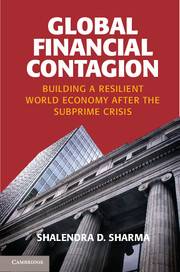Book contents
- Frontmatter
- Contents
- List of Figures
- List of Tables
- Acknowledgments
- Introduction
- One The United States
- Two The Bush and Obama Administrations’ Response
- Three From the U.S. to the European Crisis
- Four The Eurozone’s Sovereign-Debt Crisis
- Five Russia
- Six China
- Seven Japan, South Korea, and India
- Eight The Middle East amid the Global Financial Crisis
- Nine The Great Recession and the World’s Poorest
- Ten G-20 World
- Bibliography
- Index
Ten - G-20 World
Limits to Economic Cooperation in the Post-Crisis Era
Published online by Cambridge University Press: 05 June 2014
- Frontmatter
- Contents
- List of Figures
- List of Tables
- Acknowledgments
- Introduction
- One The United States
- Two The Bush and Obama Administrations’ Response
- Three From the U.S. to the European Crisis
- Four The Eurozone’s Sovereign-Debt Crisis
- Five Russia
- Six China
- Seven Japan, South Korea, and India
- Eight The Middle East amid the Global Financial Crisis
- Nine The Great Recession and the World’s Poorest
- Ten G-20 World
- Bibliography
- Index
Summary
It is a familiar story. Following every economic crisis, political leaders, finance ministers, central bank governors, policy makers, academics and other interested parties hurry back to their drawing boards to rethink and redraw the rules or “architecture” governing both the national and international economic order. Their efforts are not always in vain because economic crises, particularly crippling ones, such as the crash of 2008, create their own fortuitous dynamics and offer a rare opportunity to challenge established orthodoxies, think outside the box, put in place much-needed reforms, and, occasionally, profoundly restructure the economy. In the United States the panic of 1907 led to the Federal Reserve Act of 1913 and the creation of the Federal Reserve as the central bank. The Great Depression of the 1930s was the catalyst behind the Glass-Steagall Act, which established the Federal Deposit Insurance Corporation and the separation of commercial and investment banking. More recently, the crisis in the late 1980s led to the enactment of the Federal Deposit Insurance Corporation Improvement Act (FDICIA) of 1991, which established more clear standards for bank supervision, regulation, and capital requirements.
Seen through this prism, there is much truth in former Chief of Staff to President Obama, Rahm Emanuel’s quip that “you never want a serious crisis to go to waste.” Traumatic events like a financial crisis often mark critical junctures “when old relationships crumble and new ones have to be constructed” (Gourevitch 1986, 9). To Emanuel, the crash of 2008 offered a rare moment. The call for immediate and unambiguous action by an anxious public and a fluid political environment provided an opportunity to rise above the debilitating partisan gridlock of Washington, D.C. and implement far-reaching policy and institutional reforms that the president had been advocating. Indeed, as discussed in Chapter 2, the Obama administration took advantage of this opportunity to put in place a series of legislation designed to jump-start the stalled economy and reform the financial sector.
- Type
- Chapter
- Information
- Global Financial ContagionBuilding a Resilient World Economy after the Subprime Crisis, pp. 295 - 330Publisher: Cambridge University PressPrint publication year: 2013



